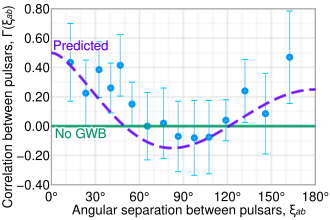
A neutron star is the collapsed core of a massive supergiant star, which had a total mass of between 10 and 25 solar masses (M☉), possibly more if the star was especially metal-rich. Except for black holes, neutron stars are the smallest and densest known class of stellar objects. Neutron stars have a radius on the order of 10 kilometers (6 mi) and a mass of about 1.4 M☉. They result from the supernova explosion of a massive star, combined with gravitational collapse, that compresses the core past white dwarf star density to that of atomic nuclei.
Cosmic strings are hypothetical 1-dimensional topological defects which may have formed during a symmetry-breaking phase transition in the early universe when the topology of the vacuum manifold associated to this symmetry breaking was not simply connected. Their existence was first contemplated by the theoretical physicist Tom Kibble in the 1970s.

Einstein@Home is a volunteer computing project that searches for signals from spinning neutron stars in data from gravitational-wave detectors, from large radio telescopes, and from a gamma-ray telescope. Neutron stars are detected by their pulsed radio and gamma-ray emission as radio and/or gamma-ray pulsars. They also might be observable as continuous gravitational wave sources if they are rapidly spinning and non-axisymmetrically deformed. The project was officially launched on 19 February 2005 as part of the American Physical Society's contribution to the World Year of Physics 2005 event.
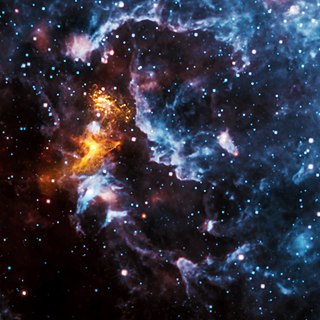
A pulsar is a highly magnetized rotating neutron star that emits beams of electromagnetic radiation out of its magnetic poles. This radiation can be observed only when a beam of emission is pointing toward Earth, and is responsible for the pulsed appearance of emission. Neutron stars are very dense and have short, regular rotational periods. This produces a very precise interval between pulses that ranges from milliseconds to seconds for an individual pulsar. Pulsars are one of the candidates for the source of ultra-high-energy cosmic rays.

A millisecond pulsar (MSP) is a pulsar with a rotational period less than about 10 milliseconds. Millisecond pulsars have been detected in radio, X-ray, and gamma ray portions of the electromagnetic spectrum. The leading theory for the origin of millisecond pulsars is that they are old, rapidly rotating neutron stars that have been spun up or "recycled" through accretion of matter from a companion star in a close binary system. For this reason, millisecond pulsars are sometimes called recycled pulsars.
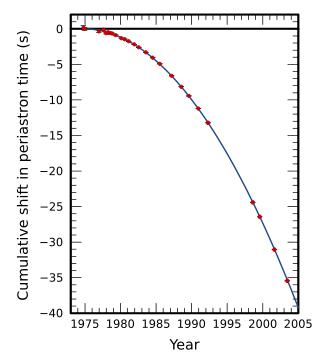
The Hulse–Taylor pulsar is a binary star system composed of a neutron star and a pulsar which orbit around their common center of mass. It is the first binary pulsar ever discovered.
The gravitational wave background is a random background of gravitational waves permeating the Universe, which is detectable by gravitational-wave experiments, like pulsar timing arrays. The signal may be intrinsically random, like from stochastic processes in the early Universe, or may be produced by an incoherent superposition of a large number of weak independent unresolved gravitational-wave sources, like supermassive black-hole binaries. Detecting the gravitational wave background can provide information that is inaccessible by any other means about astrophysical source population, like hypothetical ancient supermassive black-hole binaries, and early Universe processes, like hypothetical primordial inflation and cosmic strings.
The Tolman–Oppenheimer–Volkoff limit is an upper bound to the mass of cold, non-rotating neutron stars, analogous to the Chandrasekhar limit for white dwarf stars. Stars more massive than the TOV limit collapse into a black hole. The original calculation in 1939, which neglected complications such as nuclear forces between neutrons, placed this limit at approximately 0.7 solar masses (M☉). Later, more refined analyses have resulted in larger values.
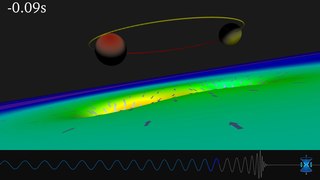
Gravitational waves are waves of the intensity of gravity that are generated by the accelerated masses of binary stars and other motions of gravitating masses, and propagate as waves outward from their source at the speed of light. They were first proposed by Oliver Heaviside in 1893 and then later by Henri Poincaré in 1905 as the gravitational equivalent of electromagnetic waves. Gravitational waves are sometimes called gravity waves, but gravity waves typically refer to displacement waves in fluids. In 1916 Albert Einstein demonstrated that gravitational waves result from his general theory of relativity as ripples in spacetime.

A gravitational-wave detector is any device designed to measure tiny distortions of spacetime called gravitational waves. Since the 1960s, various kinds of gravitational-wave detectors have been built and constantly improved. The present-day generation of laser interferometers has reached the necessary sensitivity to detect gravitational waves from astronomical sources, thus forming the primary tool of gravitational-wave astronomy.
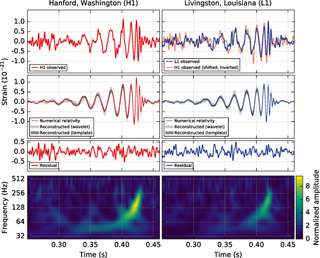
Gravitational-wave astronomy is an emerging field of science, concerning the observations of gravitational waves to collect relatively unique data and make inferences about objects such as neutron stars and black holes, events such as supernovae, and processes including those of the early universe shortly after the Big Bang.

PSR B1937+21 is a pulsar located in the constellation Vulpecula a few degrees in the sky away from the first discovered pulsar, PSR B1919+21. The name PSR B1937+21 is derived from the word "pulsar" and the declination and right ascension at which it is located, with the "B" indicating that the coordinates are for the 1950.0 epoch. PSR B1937+21 was discovered in 1982 by Don Backer, Shri Kulkarni, Carl Heiles, Michael Davis, and Miller Goss.
A pulsar timing array (PTA) is a set of galactic pulsars that is monitored and analysed to search for correlated signatures in the pulse arrival times on Earth. As such, they are galactic-sized detectors. Although there are many applications for pulsar timing arrays, the best known is the use of an array of millisecond pulsars to detect and analyse long-wavelength gravitational wave background. Such a detection would entail a detailed measurement of a gravitational wave (GW) signature, like the GW-induced quadrupolar correlation between arrival times of pulses emitted by different millisecond pulsar pairings that depends only on the pairings' angular separations in the sky. Larger arrays may be better for GW detection because the quadrupolar spatial correlations induced by GWs can be better sampled by many more pulsar pairings. With such a GW detection, millisecond pulsar timing arrays would open a new low-frequency window in gravitational-wave astronomy to peer into potential ancient astrophysical sources and early Universe processes, inaccessible by any other means.
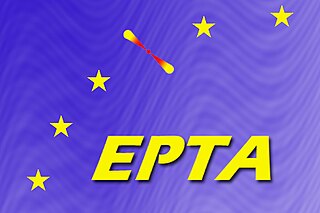
The European Pulsar Timing Array (EPTA) is a European collaboration to combine five 100-m class radio-telescopes to observe an array of pulsars with the specific goal of detecting gravitational waves. It is one of several pulsar timing array projects in operation, and one of the four projects comprising the International Pulsar Timing Array, the others being the Parkes Pulsar Timing Array, the North American Nanohertz Observatory for Gravitational Waves, and the Indian Pulsar Timing Array.
PSR J1614–2230 is a pulsar in a binary system with a white dwarf in the constellation Scorpius. It was discovered in 2006 with the Parkes telescope in a survey of unidentified gamma ray sources in the Energetic Gamma Ray Experiment Telescope catalog. PSR J1614–2230 is a millisecond pulsar, a type of neutron star, that spins on its axis roughly 317 times per second, corresponding to a period of 3.15 milliseconds. Like all pulsars, it emits radiation in a beam, similar to a lighthouse. Emission from PSR J1614–2230 is observed as pulses at the spin period of PSR J1614–2230. The pulsed nature of its emission allows for the arrival of individual pulses to be timed. By measuring the arrival time of pulses, astronomers observed the delay of pulse arrivals from PSR J1614–2230 when it was passing behind its companion from the vantage point of Earth. By measuring this delay, known as the Shapiro delay, astronomers determined the mass of PSR J1614–2230 and its companion. The team performing the observations found that the mass of PSR J1614–2230 is 1.97 ± 0.04 M☉. This mass made PSR J1614–2230 the most massive known neutron star at the time of discovery, and rules out many neutron star equations of state that include exotic matter such as hyperons and kaon condensates.
The International Pulsar Timing Array (IPTA) is a multi-institutional, multi-telescope collaboration comprising the European Pulsar Timing Array (EPTA), the North American Nanohertz Observatory for Gravitational Waves (NANOGrav), the Parkes Pulsar Timing Array (PPTA) in Australia, and the Indian Pulsar Timing Array Project (InPTA). The goal of the IPTA is to detect ultra-low-frequency gravitational waves, such as from mergers of supermassive black holes, using an array of approximately 30 pulsars. This goal is shared by each of the participating institutions, but they have all recognized that their goal will be achieved more quickly by combining their respective efforts and resources.

PSR J0348+0432 is a pulsar–white dwarf binary system in the constellation Taurus. It was discovered in 2007 with the National Radio Astronomy Observatory's Robert C. Byrd Green Bank Telescope in a drift-scan survey.

PSR J0740+6620 is a neutron star in a binary system with a white dwarf, located 4,600 light years away in the Milky Way galaxy. It was discovered in 2019, by astronomers using the Green Bank Telescope in West Virginia, U.S., and confirmed as a rapidly rotating millisecond pulsar.

Ingrid Stairs is a Canadian astronomer currently based at the University of British Columbia. She studies pulsars and their companions as a way to study binary pulsar evolution, pulsar instrumentation and polarimetry, and Fast Radio Bursts (FRBs). She was awarded the 2017 Rutherford Memorial Medal for physics of the Royal Society of Canada, and was elected as a Fellow of the American Physical Society in 2018.

The Hellings-Downs curve is an analytical tool that helps to find patterns in pulsar timing data in an effort to detect long wavelength gravitational waves. More precisely, the Hellings-Downs curve refers to the wave-like shape predicted to appear in a plot of timing residual correlations versus the angle of separation between pairs of pulsars. This theoretical correlation function assumes a gravitational wave background that is isotropic and Einsteinian.
